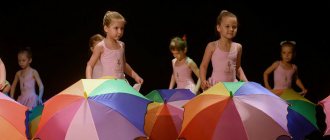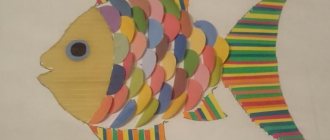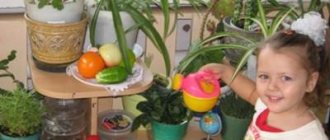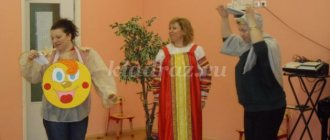Program "Young Ecologist"
Effectiveness and independence in achieving results.
Levels of a child’s mastery of program material
High level.
The child knows the basic signs of living things, establishes connections between the state of living beings, the habitat and the compliance of conditions with needs. Knowledge is generalized and systemic in nature. Masters subject concepts in accordance with the program, establishes both private and general connections independently under the guidance of a teacher. Uses observation to understand nature. Models features of objects and connections. Possesses work skills, achieving good results. He is confident enough to navigate the rules of behavior in nature and tries to adhere to them.
The child knows representatives of the animal world and divides them by species. Gives reasons for his choice. Correlates representatives of the animal world with their habitat. Names their characteristic features. Shows interest and emotionally expresses his attitude towards them. Knows how to care for domestic animals and the inhabitants of a corner of nature. Understands the relationship between human activities and the lives of animals, birds and plants. He easily expresses his attitude towards representatives of the animal world.
Classifies plants by type and knows their characteristic features. Names the conditions necessary for the life, growth and development of indoor plants. Knows how to properly care for them. He has developed practical skills and plant care skills. He shows interest and emotionally expresses his attitude towards plants.
Knows objects of inanimate nature and correctly names their distinctive characteristics. Independently gives examples of who and what they can be used for. Names the seasons correctly, lists them in the correct sequence, and knows the characteristic features of each season.
Treats nature carefully, caringly, humanely, and is intolerant of other children and adults if they violate the rules of communication with nature. Ready to provide assistance if necessary. The motive for caring for nature is an understanding of the value of life and the desire to do good deeds. The cognitive attitude is stable. Emotionally perceives nature, sees its beauty.
Average level.
The child distinguishes a large number of natural objects, identifies characteristic and - under the guidance of the teacher - essential features. Knows the signs of a living thing. Establishes private and some general connections. Able to compare objects based on differences and similarities. Uses known methods of observation to understand the laws of nature. Has not sufficiently mastered general concepts and general connections. Performs work processes independently and achieves good results. The child basically knows representatives of the animal world and divides them by species. Cannot always justify his choice. Correlates representatives of the animal world with their habitat. Sometimes he cannot name their characteristic features. Shows interest and emotionally expresses his attitude towards them. Knows how to care for domestic animals and the inhabitants of a corner of nature. Sometimes it is difficult to establish the relationship between human activity and the life of animals, birds and plants. Emotionally expresses his attitude towards representatives of the animal world. He is often passive towards manifestations of a negative attitude towards nature by other children.
Program “We are earthlings” (author N. Veresova)
The program is one of the attempts to implement the ideas of a humanitarian approach to ecology in the practice of preschool education.
The main goal of the program is to create conditions for the formation of the foundations of environmental awareness among older preschoolers. The author believes that the basis of consciousness is the value relationship of personal meanings. Ecos - home, logos - science, meaning. Treating home as an unconditional value, and in connection with this, understanding one’s place and role in the world, realizing one’s responsibility for it - this is precisely what should resonate in the soul of every child.
Objectives of the program: 1) providing conditions for the development of semantic positions, the most important of which is the position of an earthling, heir, zealous owner and defender of his home - the Earth; 2) creative self-expression of the child and teacher. Culture has accumulated not only a system of values—meanings—but also means of expressing them. During classes, the child and the adult discover and gradually master these means (through play, fairy tales, painting, folklore) and begin to use them, creating small masterpieces (riddles, poems, drawings, etc.); 3) development of the child’s abilities. This problem is solved through the use in the program of ideas of forming concepts based on meaningful generalizations (V.V. Davydov); 4) enriching children with knowledge from various fields of science, technology, literature and art.
The program has a number of features:
- playful character. Classes are not conducted in the form of a game, but are spontaneous and free play for the child and the teacher. The game is created collaboratively, not always according to a pre-planned plan or scenario. Not to teach by playing, but to build play as a way of education - this is the special role of the teacher;
— openness. Children and teachers cannot help but change its content in accordance with individual levels. It is impossible to love and cherish abstractions;
— variability. The proposed lesson notes are “worked out” options, tested and proven to be effective. But this is a script, and what the play will be like depends on the teacher and the children.
And yet, the author believes, in order for the lesson to remain holistic, the invariant basis of the program must be preserved. It contains two components: a) content - basic environmental concepts and semantic positions revealed in this lesson. The system of these concepts contains the internal logic of the program itself, the violation of which reduces its potential; b) technological invariant consists in constructing a program based on psychological patterns of development, the formation of consciousness [1, pp. 140-143].
Analysis of complex programs:
"Origins" program
“Origins” is another comprehensive program created by the psychological and pedagogical team of researchers named after. A.V. Zaporozhets. The authors consider it as a basic program aimed at the comprehensive, full development of the child, the formation of universal (including creative) abilities in him in accordance with the level of age capabilities and the requirements of modern society. The program is based on the concept of psychological age as a stage in the development of the human personality, characterized by the special relationship of a child with an adult; a certain hierarchy of activities; psychological achievements of the child, which are evidence of the development of his psyche, consciousness and personality. The authors distinguish two psychological ages in the preschool period: younger - 3-5 years and older - 5-7 years. At each age there is a main genetic task of development, which predetermines the type of leading activity. It is activity that is the factor that develops the psyche, therefore the main task of education comes down to organizing various types of activities and developing the child’s communication with adults and peers at each age, which determines the assimilation of universal human values.
In general, we can say that the “Origins” program, interesting in many respects, has not reached the modern level of full-fledged environmental education - it does not set the task of developing in children the principles of an ecological culture that considers nature as a value in all aspects of human development - cognitive, aesthetic , moral and physical. The program has important sections - health, museum pedagogy, artistic creativity, historical and geographical ideas, etc., but they are not related to the section “Nature and the Child”, and therefore do not allow the formation of a comprehensive understanding of nature and human interaction with it, cannot create a holistic picture of the world in which man and nature are connected by strong ties. The principle of child development through activity stated in the program is not sufficiently implemented; knowledge of nature, communication with it, reflection of it in the art and creativity of children involve many different types of activities that can be included in the pedagogical process [5].
Rainbow program
In the “Rainbow” program, “The World of Nature” (a subsection of the program) is a component of the cognitive development of children, within which they are given information, develop cognitive processes, form an attitude towards the world around them, which creates in children an image of the world, a holistic view of the environment. The methodological material of the program contains a significant number of lessons about plants, animals, planet Earth and the structure of the solar system. Children are given a lot of geographical knowledge and exotic information (about the nature of Africa, about dinosaurs, etc.), based on seasonal observations, “portraits” of each month are compiled, children are introduced to the history of watches, calendars, and globes. Preschoolers receive a lot of interesting knowledge, but not enough environmental knowledge. Children learn to contemplate nature, to respond emotionally to its state, but it is also important to comprehend what they see, to understand what it means. The program includes educationally attractive facts about the world and nature, but they cannot provide children with an understanding of the nature directly surrounding the child or develop a value-based attitude towards it. The frequent use of the verbal method—the teacher’s story, explanation instead of observations—cannot contribute to this either [5].
Relevance of the problem of environmental education
With the adoption of the laws of the Russian Federation “On Environmental Protection” and “On Education”, the prerequisites for the legal framework were created for the formation of a system of environmental education for the population. “The Decree of the President of the Russian Federation on environmental protection and sustainable development” (taking into account the Declaration of the UN Conference on Environment and Development, signed by Russia), the corresponding government resolutions elevate environmental education to the category of priority government problems. These documents imply the creation in the regions of the country of a system of continuous environmental education, the first link of which is preschool. It is at this age that the foundations of a person’s worldview and his relationship to the world around him are laid.
The environmental situation in the world requires a change in human behavior and a change in value orientations. To do this, everyone living on Earth needs to understand the real position of man as a biological species that exists on our planet along with other, no less significant species. We must understand the limited natural resources of the territories used. Today, more and more countries, including ours, are joining the implementation of the concept of sustainable development. According to this concept, people must comply with the laws of nature and change their consumer attitude towards it to recognize its intrinsic value: on the one hand, the interests of people and their desire to create acceptable living conditions for themselves must be taken into account, on the other hand, human aspirations should be limited by the framework of natural laws.
To put these principles into practice, we need people with new thinking. That is why, all over the world, more and more attention has recently been paid to environmental education. Achieving the goals declared in the modern concept of sustainable development is possible only through environmental education. The “Concept of Sustainable Development of Russia” contains a section “Environmental education, greening of public consciousness.” It especially emphasizes the formation by all available means of an ecological worldview of Russian citizens, and first of all children. This approach requires analyzing the content and methodology of environmental education for preschoolers.
First of all, we must pay attention to the following issues.
- Understanding the intrinsic value of nature.
- The child’s awareness of himself as a part of nature.
- Cultivating a respectful attitude towards all species without exception, regardless of our likes and dislikes.
- Understanding that everything in nature is interconnected and the violation of one of the connections leads to other changes: a “chain reaction” occurs.
- Raising an active life position in children.
- Teaching the basics of basic environmental safety.
- Formation of initial information about the rational use of natural resources using the example of the use of water and energy in everyday life.
- Formation of environmentally literate behavior in everyday life and in nature.
- Formation of an emotionally positive attitude towards the world around us, understanding the dependence of its state on the actions of a person (including a child).
- Understanding the uniqueness and beauty of the surrounding world.
For many years, society was aimed at transforming nature, at “taking all its riches,” and man considered himself a winner, a conqueror of nature. This is the main idea of anthropocentrism, which is widespread in many ways today, including in preschool education. This means that in the human-nature relationship, man views himself as the main actor who can remake his environment as he pleases, for his own good. The younger generation can and should develop a new - ecological - consciousness.
Then this generation will build its relationship with nature from a different position -
the position of biocentrism,
which means:
man is special, intelligent, but still only a part of nature, and ecology is not just a science, it is a worldview!
Whatever a child becomes in the future, he must understand well his role in the world around him, be aware of the consequences of his actions, and have an understanding of the laws of nature.
“Krokha” program
“Krokha” is a program for educating the youngest (young children) in the family and kindergarten. E. F. Terentyeva (author of the program section) highlights a number of circumstances that adults can use to introduce children to nature. If there are plants, animals, or animals in the room (at home or in kindergarten), adults can attract children to observations and joint care, evoke in them an emotional response to the beauty and various manifestations of living beings. The whole world opens up to children from the window of the room - an adult can show a child a lot. Walking can also be used for environmental education. The author gives recommendations on what and how you can observe with children in different seasons, how to play with them in nature and with natural materials [5].
Program "Childhood"
In the “Childhood” program, created at the St. Petersburg State Pedagogical University, the section “A child discovers the world of nature” involves a thorough acquaintance of children with a wide variety of phenomena from the life of plants, animals, and their communities.
The program material (for each age) includes four content blocks:
The first is information about plants and animals as representatives of wildlife; children learn the features of the external structure and vital functions of the body (nutrition, breathing, etc.), the connections of living beings with their environment, their uniqueness are revealed to them.
The second block reveals to children the mechanisms of adaptive relationships between living organisms and their environment; children become familiar with the properties of various environments in detail, they form an idea of groups of animals living in a homogeneous environment.
The third block is knowledge about the growth, development and reproduction of plants and animals familiar to children; children gain an understanding of the sequential changes in organisms and the cyclical nature of the process.
The fourth block is knowledge of an ecosystem nature; children get acquainted with plants and animals living in the same community and their interdependence. Children will also learn that a person can influence communities of living organisms in different ways - he can destroy them, or he can support them.
Thus, “Childhood” is a program not only for the enriched multifaceted development of a preschooler’s personality, it is a comprehensive program with an environmental bias, providing the child with both comprehensive development and the formation of the initial stage of an ecological worldview. This combination can contribute in the future (subject to continuity of environmental education) to the development of full-fledged environmental consciousness, which will determine the activities of an adult in everyday life, on vacation and at work [5; p. 119].
Development program
The “Development” program, developed by a team of child psychologists, is aimed at developing the intellectual and artistic abilities of preschoolers, which are understood as indicative actions with imaginative means of solving problems. Developed abilities help the child to independently navigate new situations, find the necessary solutions, and have a meaningful attitude towards his own activities. Based on the sensory abilities formed in early preschool age, the ability for visual modeling develops in middle and older preschool age. Familiarization with nature, included in the “Development” program, is one of the means of developing children’s different abilities and does not pose the task of their environmental education. Children learn the simplest forms of symbolic reflection of natural objects, their condition, changes, and relationships. The program has an educational tendency towards environmental education of preschool children [5].





